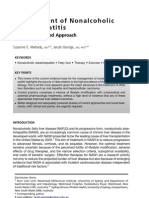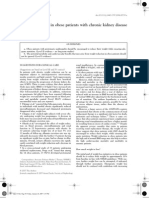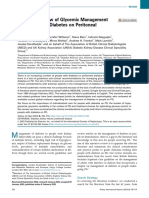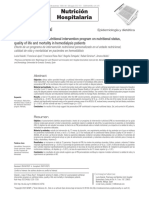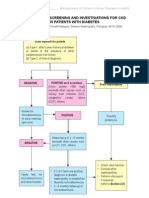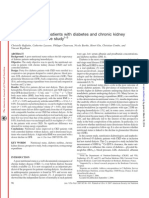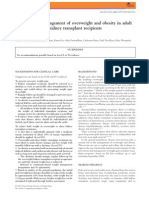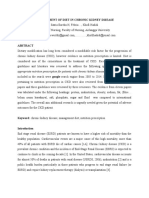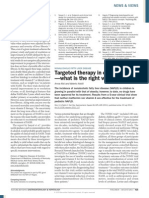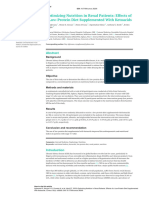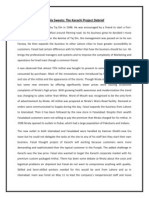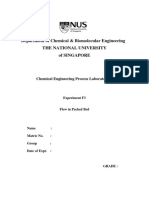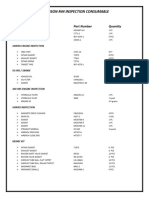Nutritional Intervention in Chronic Kidney Disease: Editorial
Nutritional Intervention in Chronic Kidney Disease: Editorial
Uploaded by
Daniel DarmawanCopyright:
Available Formats
Nutritional Intervention in Chronic Kidney Disease: Editorial
Nutritional Intervention in Chronic Kidney Disease: Editorial
Uploaded by
Daniel DarmawanOriginal Description:
Original Title
Copyright
Available Formats
Share this document
Did you find this document useful?
Is this content inappropriate?
Copyright:
Available Formats
Nutritional Intervention in Chronic Kidney Disease: Editorial
Nutritional Intervention in Chronic Kidney Disease: Editorial
Uploaded by
Daniel DarmawanCopyright:
Available Formats
EDITORIAL
Nutritional Intervention in Chronic
Kidney Disease
IETARY PROTEIN RESTRICTION has
been prescribed in chronic kidney disease
(CKD) for a century, and a low-protein diet
(LPD) or supplemented very low-protein diet
with ketoanalogs of amino acids (SVLPD) has
been prescribed for four decades. It was argued
that such a regimen may be associated with a deterioration of nutritional status. Such intervention is uncommon now in the United States
and in most European countries, in which a standard diet with 0.8 g/kg/day of protein is commonly used. At the same time, most patients
present signs of protein-energy malnutrition at
the start of renal replacement therapy (RRT),
even if they have consulted a nephrologist in
the preceding months or years. The Comprehensive Dialysis Study, which is part the United States
Renal Data System (USRDS) 2008 data report,
involved a special collection of data on the nutrition, activity, and quality of life of patients who
initiated RRT between 2005 and 2007. The first
results showed that at the start of RRT, 60%
of patients exhibited a serum albumin level lower than 35 g/L, and in 80% of these patients,
the alimentary intake was below the actual
recommendations.1
In contrast, during the last several decades,
no study demonstrated that LPD or SVLPD
was associated with malnutrition. The first and
second analyses of the Modification of Diet in
Renal Diseases (MDRD)-Study concluded that
such a regimen is safe in uncomplicated and
carefully monitored cases. Short-term follow-up
P. C. received a consultancy fee.
This article was published as part of a supplement sponsored by an
unrestricted educational grant from Fresenius Kabi.
2009 by the National Kidney Foundation, Inc. All rights
reserved.
1051-2276/09/1905S-0001$36.00/0
doi:10.1053/j.jrn.2009.06.018
Journal of Renal Nutrition, Vol 19, No 5S (September), 2009: pp S1S2
of SVLPD patients showed no adverse nutritional effects after patients started dialysis, or
during and after transplantation. One could object that these patients were carefully selected
and monitored. This last point is important, because a nutritional survey should be the main
feature of an adequate, long-term follow-up
of CKD patients before RRT. The implementation of nutritional guidelines is associated
with better results.2 A review of the literature
regarding protein intake and CKD confirmed
that nutritional therapy is effective to reduce
comorbidities associated with CKD: nutrition,
phosphate intake, proteinuria, and cardiovascular risk factors.
All the reports from this symposium demonstrate that nutritional intervention in CKD patients is not an outmoded therapy based on
antiquated clinical studies, and that a supplemented, protein-restricted diet has its place in
a therapeutic approach. The long-term followup of patients in previous studies confirmed
the safety and nutritional adequacy of these diets, and recent clinical studies of nondiabetic
and diabetic patients led to the same conclusions. The experimental and clinical studies reported in this issue of the Journal illustrate all
the mechanisms (and new directions) involved
in the beneficial effects of LPDs supplemented
with keto acids/amino acids: the effects on proteinuria and endothelial dysfunction, specific
effects of branched-chain amino acids, effects
of keto acids/amino acids on asymmetric dimethylarginine and body fat mass, and effects on
glomerular structure and renal fibrosis. Clinical
studies confirm previous studies and metaanalyses: SVLPDs delay the time to RRT, and
could be of economic importance. Clinical
studies also confirm the positive effects suggested by experimental data in terms of obese
transplanted patients, diabetic patients, and the
preservation of renal function in peritoneal
dialysis patients. To help nephrologists and
S1
S2
EDITORIAL
dietitians, the expert panel proposes a consensus
statement on keto acid therapy in diabetic or
nondiabetic predialysis patients and in nephrotic
syndrome.
In conclusion, nutritional interventions and
specifically supplemented very low protein diets
have many proven advantages in terms of the
progression of renal failure, better metabolic and
endocrine control, and decreased proteinuria.
Patients are in need of a detailed nutritional
survey by dietitians and nephrologists. This should
be the case for all CKD patients, but especially for
SVLPD patients, to avoid malnutrition. Toward
this goal, all the data reported in this issue by
international experts on this topic will help.
and will offer some new directions for future
research.
Philippe Chauveau, MD
Nephrology Department, Hopital Pellegrin and
Aurad-Aquitaine, Bordeaux, France
References
1. Kutner NG, Johansen KL, Kaysen GA, et al: The Comprehensive Dialysis Study (CDS): a USRDS special study. Clin J Am
Soc Nephrol 4:645650, 2009.
2. Campbell KL, Ash S, Zabel R, McFarlane C, Juffs P,
Bauer JD: Implementation of standardized nutrition guidelines
by renal dietitians is associated with improved nutrition status.
J Ren Nutr 19:136144, 2009.
You might also like
- Appendix 3.8d Utility Service Diversion Management PlanDocument4 pagesAppendix 3.8d Utility Service Diversion Management PlanTAHER AMMARNo ratings yet
- c-130 Service New Vol. 1 Nr. 3 1974Document24 pagesc-130 Service New Vol. 1 Nr. 3 1974angelo marraNo ratings yet
- Making The GradeDocument4 pagesMaking The Gradejuancho1994No ratings yet
- DIET in Chronic Kidney DiseaseDocument3 pagesDIET in Chronic Kidney Diseaseatul_desai_3No ratings yet
- 632 Management of Nonalcoholic SteatohepatitisDocument15 pages632 Management of Nonalcoholic Steatohepatitispedrogarcia7No ratings yet
- CKD PPKD Weight Reduction 310107Document3 pagesCKD PPKD Weight Reduction 310107Geoffrey HoNo ratings yet
- Nutrition Therapy For Liver Diseases Based On TheDocument8 pagesNutrition Therapy For Liver Diseases Based On Thepainah sumodiharjoNo ratings yet
- Pi Is 2468024923000499Document15 pagesPi Is 2468024923000499Juan Carlos BarriNo ratings yet
- Nutritional Status in Peritoneal Dialysis Nutritional Guidelines, Adequacy and The Management of MalnutritionDocument14 pagesNutritional Status in Peritoneal Dialysis Nutritional Guidelines, Adequacy and The Management of MalnutritionrocastelviNo ratings yet
- Fluid and Dietary Restriction's Effi Cacy On Chronic Kidney Disease Patients in HemodialysisDocument9 pagesFluid and Dietary Restriction's Effi Cacy On Chronic Kidney Disease Patients in HemodialysisfitriNo ratings yet
- CKD 6Document8 pagesCKD 6Khusnu Waskithoningtyas NugrohoNo ratings yet
- Capstone Final Justin IsnerDocument21 pagesCapstone Final Justin Isnerapi-312746225No ratings yet
- Short Bowel Syndrome Searching For The Proper.2Document3 pagesShort Bowel Syndrome Searching For The Proper.2Jennifer RodriguezNo ratings yet
- PIIS2405457716301917Document2 pagesPIIS2405457716301917Abbas AmirNo ratings yet
- Management of Lifestyle Factors in Individuals With Cirrhosis: A Pragmatic ReviewDocument9 pagesManagement of Lifestyle Factors in Individuals With Cirrhosis: A Pragmatic ReviewsavitageraNo ratings yet
- Dialysis Free Protocol For Some End Stage Renal Disease PatientsDocument7 pagesDialysis Free Protocol For Some End Stage Renal Disease PatientsDannieCiambelliNo ratings yet
- Medical Nutrition Therapy For Hemodialysis PatientsDocument24 pagesMedical Nutrition Therapy For Hemodialysis Patientsraquelt_65No ratings yet
- Artigo Dieta Anti-Inflamatória No MetabolismoDocument12 pagesArtigo Dieta Anti-Inflamatória No MetabolismoRegiane De Sousa LimaNo ratings yet
- Art 2Document6 pagesArt 2lorenabfeijo46No ratings yet
- 1Document1 page1raveen putraNo ratings yet
- Gfy 164Document9 pagesGfy 164agiosteos2No ratings yet
- 1 s2.0 S0085253815560973 MainDocument12 pages1 s2.0 S0085253815560973 MainTri Veny AfreNo ratings yet
- Analysis of Nutrition and Nutritional Status of HaDocument11 pagesAnalysis of Nutrition and Nutritional Status of HaVione rizkiNo ratings yet
- Nutrients: Ffects of Different Quantities and Qualities ofDocument12 pagesNutrients: Ffects of Different Quantities and Qualities ofLucas CanaleNo ratings yet
- 10.1007@s11154 019 09514 yDocument12 pages10.1007@s11154 019 09514 ysimonNo ratings yet
- Diabetes Obesity Metabolism - 2024 - Sloan - The Role of Basal Insulins in The Treatment of People With Type 2 Diabetes andDocument14 pagesDiabetes Obesity Metabolism - 2024 - Sloan - The Role of Basal Insulins in The Treatment of People With Type 2 Diabetes andMario TrombettaNo ratings yet
- Weaningfromparenteral Nutrition: Andrew UklejaDocument26 pagesWeaningfromparenteral Nutrition: Andrew UklejaJosebeth RisquezNo ratings yet
- diet-therapy-along-with-nutrition-education-can-improve-renal-function-in-people-with-stages-3-4-chronic-kidney-disease-who-do-not-have-diabetes-a-randomised-controlled-trialDocument11 pagesdiet-therapy-along-with-nutrition-education-can-improve-renal-function-in-people-with-stages-3-4-chronic-kidney-disease-who-do-not-have-diabetes-a-randomised-controlled-trialggabrielacsouzaNo ratings yet
- EssayDocument16 pagesEssayLorenz Sagayaga ListaNo ratings yet
- ERC PotasioDocument10 pagesERC PotasioAbrilNo ratings yet
- Dietary Fiber Intake and Glycemic Control: Coronary Artery Calcification in Type 1 Diabetes (CACTI) StudyDocument8 pagesDietary Fiber Intake and Glycemic Control: Coronary Artery Calcification in Type 1 Diabetes (CACTI) StudyLeonardo AzevedoNo ratings yet
- alkali diyet ve böbrekDocument10 pagesalkali diyet ve böbrekdytcrnkhrmnNo ratings yet
- jurnal ebpDocument7 pagesjurnal ebpsyaadhainadilaNo ratings yet
- Nutrición y Enfermedad RenalDocument7 pagesNutrición y Enfermedad RenalTeresa La parra AlbaladejoNo ratings yet
- jurnal ebpDocument7 pagesjurnal ebpsyaadhainadilaNo ratings yet
- 0717 7518 Rchnut 51 01 0094Document7 pages0717 7518 Rchnut 51 01 0094GlauciaNo ratings yet
- CPG Management of Chronic Kidney Disease in Adults June 2011Document47 pagesCPG Management of Chronic Kidney Disease in Adults June 2011Kokoland KukusNo ratings yet
- Nutritional Status in Patients With Diabetes and Chronic Kidney Disease: A Prospective StudyDocument6 pagesNutritional Status in Patients With Diabetes and Chronic Kidney Disease: A Prospective StudyHenry HadiantoNo ratings yet
- Nutrition in Patients On Peritoneal Dialysis PDFDocument13 pagesNutrition in Patients On Peritoneal Dialysis PDFCarlos Navarro YslaNo ratings yet
- JurnalDocument6 pagesJurnalRahmat YusufNo ratings yet
- JURNALDocument12 pagesJURNALJessica GraciaNo ratings yet
- Wiliam Yancy PDFDocument7 pagesWiliam Yancy PDFDeaz Fazzaura PutriNo ratings yet
- Lower serum zinc levels are associated with unhealthy metabolic status in normal weight adults The 201Document9 pagesLower serum zinc levels are associated with unhealthy metabolic status in normal weight adults The 201wahabsayang56No ratings yet
- APznzaZU0hHm7eNTBnF-8sZrfGGMRiUq9sCQrpc6QvVA-0SekU0HQcTlgaHI164hI97v9QLN_fUspEMwYZeEHeOUC-4fC4SD8X76XF2y458LFPUEP-B-pD7LWLiCAy_wIQm2rOGXcC8Document18 pagesAPznzaZU0hHm7eNTBnF-8sZrfGGMRiUq9sCQrpc6QvVA-0SekU0HQcTlgaHI164hI97v9QLN_fUspEMwYZeEHeOUC-4fC4SD8X76XF2y458LFPUEP-B-pD7LWLiCAy_wIQm2rOGXcC8IsaNo ratings yet
- Dietary and Medical Management of Short Bowel SyndDocument10 pagesDietary and Medical Management of Short Bowel SyndMariana YudiNo ratings yet
- Manejo Sobrep e Obesidade Pos TX. Chadban Et Al., 2010Document4 pagesManejo Sobrep e Obesidade Pos TX. Chadban Et Al., 2010Priscila MansurNo ratings yet
- Management of Diet in Chronic Kidney DiseaseDocument5 pagesManagement of Diet in Chronic Kidney DiseaseSean EurekaNo ratings yet
- PIIS1530891X22000908Document35 pagesPIIS1530891X22000908Aarón GonzálezNo ratings yet
- Kdoqi Clinical Practice Guideline For Nutrition in CKD (1) (051-107)Document57 pagesKdoqi Clinical Practice Guideline For Nutrition in CKD (1) (051-107)Lais AlcântaraNo ratings yet
- Lifestyle Choices and Chronic Kidney Disease:: Dietary Habits and Nutritional ManagementDocument6 pagesLifestyle Choices and Chronic Kidney Disease:: Dietary Habits and Nutritional ManagementBalwayan, January DwayneNo ratings yet
- Nutritional Support in Patients With Oesophageal CancerDocument10 pagesNutritional Support in Patients With Oesophageal Cancersinghurvashi365No ratings yet
- Clinician Guide Inpx LCD For Remission T2DM Toward STD Care Protocol Diabetes Manag 2019 9-Cucuzzella Hite Patterson EtalDocument28 pagesClinician Guide Inpx LCD For Remission T2DM Toward STD Care Protocol Diabetes Manag 2019 9-Cucuzzella Hite Patterson Etaldonmd98No ratings yet
- 2 2. Medical Nutrition Therapy: 2.1. Protein and Renal FunctionDocument1 page2 2. Medical Nutrition Therapy: 2.1. Protein and Renal Functionraveen putraNo ratings yet
- Nuevas Terapias para La Obesidad - Euro Soc Cardiol 2023Document18 pagesNuevas Terapias para La Obesidad - Euro Soc Cardiol 2023endobariatryNo ratings yet
- Enf. Hepatica PDFDocument10 pagesEnf. Hepatica PDFPia EscobalNo ratings yet
- Kidney Disease ThesisDocument5 pagesKidney Disease Thesissoniasancheznewyork100% (2)
- Nrgastro 2011Document2 pagesNrgastro 2011James LeungNo ratings yet
- Nutritional Management and Dietary Guidelines For Cancer CachexiaDocument3 pagesNutritional Management and Dietary Guidelines For Cancer CachexiaShalah Marie UbaldoNo ratings yet
- Indications For Initiation of DialysisDocument11 pagesIndications For Initiation of DialysisMilton BenevidesNo ratings yet
- Dia Care-1998 - S32-5Document4 pagesDia Care-1998 - S32-5Vasu KodagantiNo ratings yet
- Izccx3Document7 pagesIzccx3Maya AzizahNo ratings yet
- Complementary and Alternative Medical Lab Testing Part 8: UrologyFrom EverandComplementary and Alternative Medical Lab Testing Part 8: UrologyRating: 3 out of 5 stars3/5 (1)
- The Fourth Word: "My God, My God, Why Have You Abandoned Me?" (Mark 15:34)Document7 pagesThe Fourth Word: "My God, My God, Why Have You Abandoned Me?" (Mark 15:34)DexNo ratings yet
- APPLICATIONDocument35 pagesAPPLICATIONRonald Jay LacisteNo ratings yet
- Multiple ChoiceDocument31 pagesMultiple ChoiceMARY ROSE RECIBENo ratings yet
- N R Campbell - ScienceDocument216 pagesN R Campbell - Sciencericardo garciaNo ratings yet
- JIO Enterprise AnalysisDocument39 pagesJIO Enterprise AnalysisRishabhJaysawalNo ratings yet
- Prudente vs. Judge DayritDocument6 pagesPrudente vs. Judge DayritEarl NuydaNo ratings yet
- 1 s2.0 S1049964419307510 MainDocument18 pages1 s2.0 S1049964419307510 MainGenaina CristofoliNo ratings yet
- Nirala SweetsDocument2 pagesNirala SweetsQaiserNo ratings yet
- 9 Steps To Reverse DementiaDocument36 pages9 Steps To Reverse DementiaLavinia PirlogNo ratings yet
- User Manual FW Update Tool ENGDocument11 pagesUser Manual FW Update Tool ENGWingchard Cejes MonponbanuaNo ratings yet
- F3 Packed BedDocument4 pagesF3 Packed BederickhadinataNo ratings yet
- Training Units: Simatic S7Document7 pagesTraining Units: Simatic S7chochoroyNo ratings yet
- HROB 2090 Midterm NotesDocument26 pagesHROB 2090 Midterm Notescalesi3392No ratings yet
- Kyle Lit Review Pop CultureDocument4 pagesKyle Lit Review Pop CultureCyril CauilanNo ratings yet
- Further MathematicsDocument5 pagesFurther MathematicsBabatunde Victor Junior100% (1)
- 9107 PDFDocument521 pages9107 PDFJesus Carhuamaca Pascual100% (3)
- Brochure - MBA 20 Pages (PDF - Io)Document20 pagesBrochure - MBA 20 Pages (PDF - Io)Priyanshu Bajaj100% (1)
- Machine 5 PrintDocument12 pagesMachine 5 PrintLove Nepal Is BackNo ratings yet
- The Meaning of Authenticity and The Early Music MovementDocument16 pagesThe Meaning of Authenticity and The Early Music MovementLuiz Henrique Mueller MelloNo ratings yet
- The Day I Lost You by Fionnuala Kearney - ExtractDocument31 pagesThe Day I Lost You by Fionnuala Kearney - ExtractAnonymous ikUR753am100% (1)
- FInal TYBCA Java Slips VIiiiDocument7 pagesFInal TYBCA Java Slips VIiiiSOHAIL PATHAN2No ratings yet
- Applications of Palynology in Stratigraphy and Climate Studies (Bandana Samant, Deepali Thakre) (Z-Library)Document351 pagesApplications of Palynology in Stratigraphy and Climate Studies (Bandana Samant, Deepali Thakre) (Z-Library)022abbasabbasNo ratings yet
- Capital Structure MCQsDocument27 pagesCapital Structure MCQsTejas BhavsarNo ratings yet
- R44 Inspection ListDocument2 pagesR44 Inspection ListskytacticaeroNo ratings yet
- Maxwell Equations:: The Physics of Electromagnetism Is Described by The Maxwell's Equations and The Lorentz Force LawDocument11 pagesMaxwell Equations:: The Physics of Electromagnetism Is Described by The Maxwell's Equations and The Lorentz Force LawSam BrownNo ratings yet
- Station Post Catalog 143Document8 pagesStation Post Catalog 143dageb2012No ratings yet
- Pipe Contraction Pressure LossDocument8 pagesPipe Contraction Pressure LossblumunchieNo ratings yet




